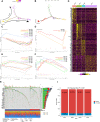Integrating Single-cell RNA-seq to construct a Neutrophil prognostic model for predicting immune responses in non-small cell lung cancer
- PMID: 36401283
- PMCID: PMC9673203
- DOI: 10.1186/s12967-022-03723-x
Integrating Single-cell RNA-seq to construct a Neutrophil prognostic model for predicting immune responses in non-small cell lung cancer
Abstract
Non-small cell lung cancer (NSCLC) is the most widely distributed tumor in the world, and its immunotherapy is not practical. Neutrophil is one of a tumor's most abundant immune cell groups. This research aimed to investigate the complex communication network in the immune microenvironment (TIME) of NSCLC tumors to clarify the interaction between immune cells and tumors and establish a prognostic risk model that can predict immune response and prognosis of patients by analyzing the characteristics of Neutrophil differentiation. Integrated Single-cell RNA sequencing (scRNA-seq) data from NSCLC samples and Bulk RNA-seq were used for analysis. Twenty-eight main cell clusters were identified, and their interactions were clarified. Next, four subsets of Neutrophils with different differentiation states were found, closely related to immune regulation and metabolic pathways. Based on the ratio of four housekeeping genes (ACTB, GAPDH, TFRC, TUBB), six Neutrophil differentiation-related genes (NDRGs) prognostic risk models, including MS4A7, CXCR2, CSRNP1, RETN, CD177, and LUCAT1, were constructed by Elastic Net and Multivariate Cox regression, and patients' total survival time and immunotherapy response were successfully predicted and validated in three large cohorts. Finally, the causes of the unfavorable prognosis of NSCLC caused by six prognostic genes were explored, and the small molecular compounds targeted at the anti-tumor effect of prognostic genes were screened. This study clarifies the TIME regulation network in NSCLC and emphasizes the critical role of NDRGs in predicting the prognosis of patients with NSCLC and their potential response to immunotherapy, thus providing a promising therapeutic target for NSCLC.
Keywords: Immunotherapy response; NSCLC; Neutrophil; Prognosis; Tumor immune microenvironment; scRNA-seq.
© 2022. The Author(s).
Conflict of interest statement
The authors declare that they have no competing interests in this section.
Figures







References
-
- Imyanitov EN, Iyevleva AG, Levchenko EV. Molecular testing and targeted therapy for non-small cell lung cancer: current status and perspectives. Crit Rev Oncol Hematol. 2021;157:103194. - PubMed
-
- Duma N, Santana-Davila R, Molina JR. Non-small cell lung cancer: epidemiology, screening, diagnosis, and treatment. Mayo Clin Proc. 2019;94(8):1623–1640. - PubMed
-
- Antonia SJ, Villegas A, Daniel D, Vicente D, Murakami S, Hui R, et al. Overall survival with durvalumab after chemoradiotherapy in stage III NSCLC. N Engl J Med. 2018;379(24):2342–2350. - PubMed
-
- Mestas J, Hughes CC. Of mice and not men: differences between mouse and human immunology. J Immunol. 2004;172(5):2731–2738. - PubMed
Publication types
MeSH terms
LinkOut - more resources
Full Text Sources
Medical
Research Materials
Miscellaneous

